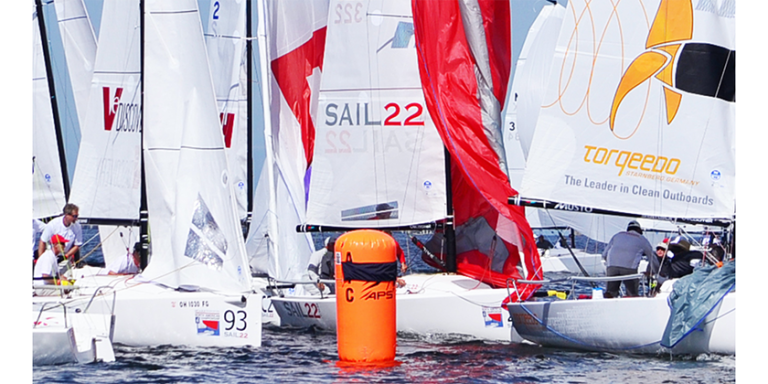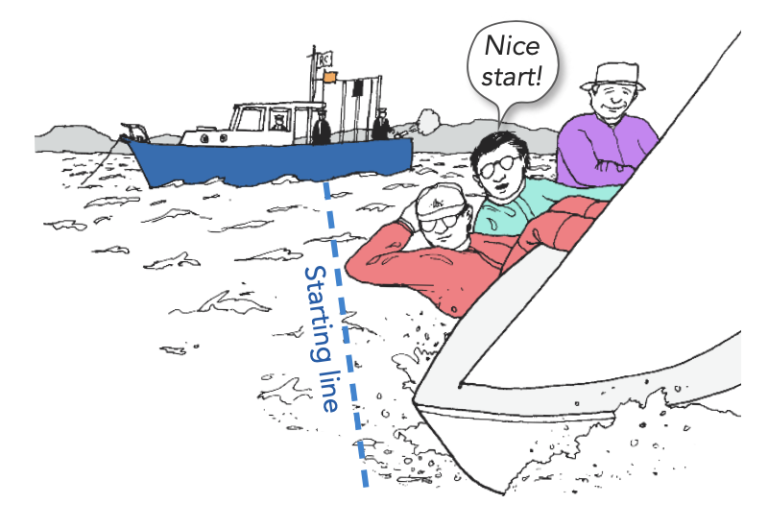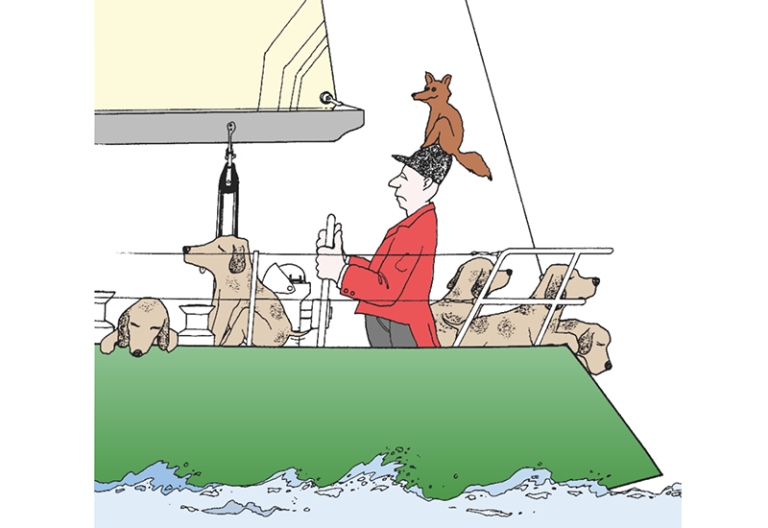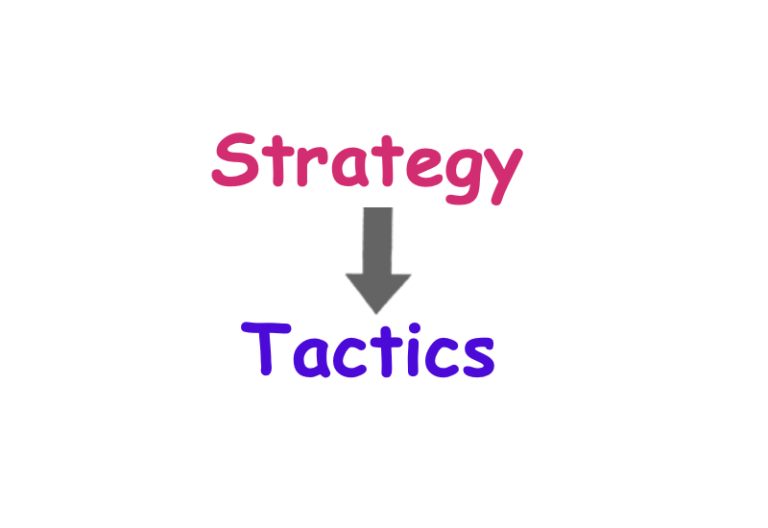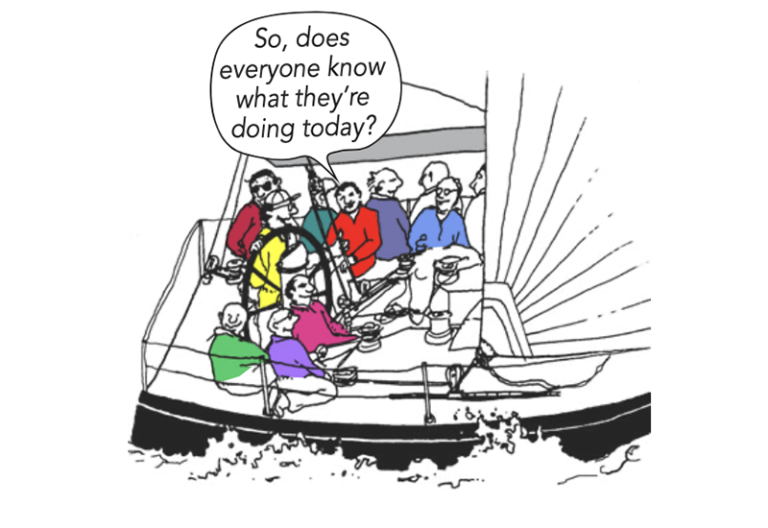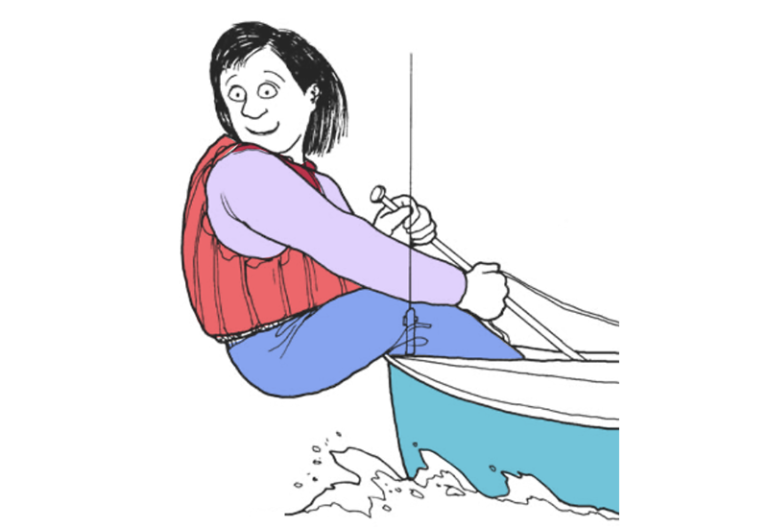Speed & Smarts: Light and Heavy Air Differences – Part 2: the effect of wind velocity on strategic choices
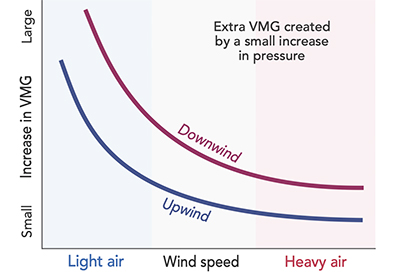
August 3, 2022
In most races, two key strategic variables seem to have by far the biggest impact on boats’ overall success (or failure). These are wind velocity (‘pressure’) and changes in wind direction (‘shifts’).
If you find the best pressure on the course and also play the shifts correctly, you’ll be in great shape. But sometimes you can’t do both at the same time. Often you must choose between sailing toward the best pressure or playing a wind shift correctly. Which is better?
In many ‘puff-or-shift’ situations, the better strategy depends on how much wind there is. In heavy air, you likely have plentyof power and are sailing almost as fast as the boat will go. In this case, another couple knots of wind will not improve your speed or height much. But sailing the lifted tack upwind (or the headed jibe down- wind) will be very helpful getting to the next mark. Therefore, when it’s breezy, a good rule of thumb is to play the shifts first and don’t worry so much about the puffs.
In light air the opposite is true. When you’re sailing slowly, even a tiny increase in pressure can have a significant impact on your speed. If the average wind speed is seven knots, a two-knot puff represents a huge increase in power!
In addition to giving you better speed through the water, a puff is like a shift because it allows you to point higher upwind (and lower downwind). These are two great reasons why finding extra velocity should be your top priority when the wind is relatively light.
Shifts can also be valuable in light air, but a lift (or header on a run) without good pressure is not very helpful. Once it gets windy enough that more wind will not increase your speed or height very much, shifts are especially critical.
Assessing the value of extra wind velocity Finding a small increase in pressure will help you much more in light air than it will in heavy air. When you already have enough wind to be fully powered up, a little more wind won’t make you sail much faster or higher upwind, so it doesn’t help your VMG (velocity-made-good) much. In light air, though, even a little more velocity can have a huge impact on your upwind speed! The same trend is true downwind, though a small increase in pressure will be slightly more beneficial for your VMG in all wind velocities.
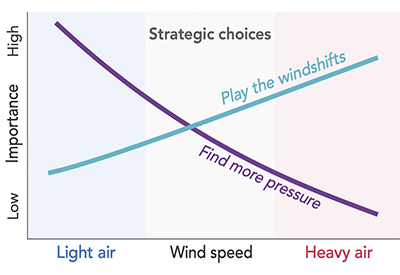
Determining strategic priorities in light and heavy air
ABOVE: Here’s a simple graphic showing basic strategic priorities over a range of wind velocities (roughly covering both upwind and downwind). In light air, it’s generally more important to find better pressure than look for windshifts, while in heavy air the opposite is usually true.
BELOW: Here’s another way to visualize strategic choices, with upwind
and downwind shown separately. When you’re sailing downwind in light air, pressure is all-important. On a very subjective scale of 0 to 100, I would give pressure an 80 and finding shifts a 20. For upwind in light air, pressure is still key (70) but finding shifts is slightly more valuable (30).
In heavy air, the numbers are basically reversed. When you’re sailing upwind, extra pressure won’t improve your performance much so I give it a 20. That makes playing the shifts very important (80). On a run, more pressure will almost always improve speed, so this is a bit more valuable (40). But finding shifts is probably still the priority (60). Of course, we can tweak these numbers quite a bit depending on boat type and whether you are sailing at the low or high end of each wind range.

How big is the puff or shift?
Any decision about pursuing a puff or shift depends on the size of the puff or shift, of course. Are you choosing between a 10° shift and a one-knot puff? Or a 2° shift and five more knots of pressure? And will the puff or shift last the rest of the leg, or just 30 seconds? Most strategic choices are not as simple as ‘puff or shift.’ They require good observation and assessment of a multitude of factors.
Five questions to ask
When you’re trying to decide if you should head for a puff on the left side or sail a good shift toward the right, ask yourself these questions:
Underpowered or overpowered?
When you’re sailing upwind, are you constantly looking for more power, or do you have too much? If you are underpowered, finding more pressure will always be more valuable than if you are flogging your sails to keep the boat flat.
Upwind or downwind?
As a general rule of thumb, shifts are more beneficial on beats while pressure is more valuable on runs, largely because 1) puffs stay with you longer downwind, and 2) puffs allow you to sail deeper downwind, so they are like shifts. But making a strategic choice also depends on wind velocity. The lighter the wind, the more you should lean toward finding more pressure, no matter what leg you’re on (see above).
How big is the puff or shift
Any decision about pursuing a puff or shift depends on the size of the puff or shift, of course. Are you choosing between a 10° shift and a one-knot puff? Or a 2° shift and five more knots of pressure? And will the puff or shift last the rest of the leg, or just 30 seconds? Most strategic choices are not as simple as ‘puff or shift.’ They require good observation and assessment of a multitude of factors.
What is the cost of playing the puff or shift?
Will you have to tack or jibe (once, or maybe twice) to pursue either strategy? The cost of boathandling varies with wind velocity (see next issue column). If a maneuver costs you more than the amount you will gain by making it, then it’s probably not the right move.
Planing or surfing?
If you’re sailing downwind, will a little extra pressure allow you to surf or plane? If so, you should almost always go for more wind.
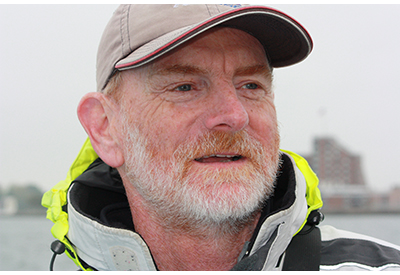 Dave Dellenbaugh is the publisher, editor and author of Speed & Smarts, the racing newsletter. He was the tactician and starting helmsman on America3 during her successful defense of the America’s Cup in 1992 and sailed in three other America’s Cup campaigns from 1986 to 2007. David is also two-time winner of the Canada’s Cup, a Lightning world champion, two-time Congressional Cup winner, seven-time Thistle national champion, three-time Prince of Wales U.S. match racing champion and past winner of the U.S. Team Racing Championship for the Hinman Trophy. He is currently a member of the US Sailing Racing Rules Committee (and was its chairman from 2005-2008).
Dave Dellenbaugh is the publisher, editor and author of Speed & Smarts, the racing newsletter. He was the tactician and starting helmsman on America3 during her successful defense of the America’s Cup in 1992 and sailed in three other America’s Cup campaigns from 1986 to 2007. David is also two-time winner of the Canada’s Cup, a Lightning world champion, two-time Congressional Cup winner, seven-time Thistle national champion, three-time Prince of Wales U.S. match racing champion and past winner of the U.S. Team Racing Championship for the Hinman Trophy. He is currently a member of the US Sailing Racing Rules Committee (and was its chairman from 2005-2008).
You can subscribe to the Speed & Smarts newsletter HERE.

